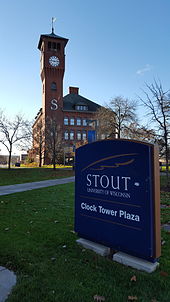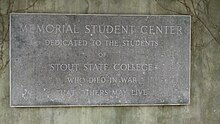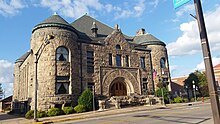Menomonie, Wisconsin History
(This project is under construction by ENGL 101_033, 020, and 045 at UW-Stout. Contact user emistuemke for information.)
The first form of industry in the Menomonie area was fur trading. Small forts would be set up near native tribes where they would trade furs for European goods, mainly tools and weapons. After fur trading became more challenging due to over hunting, logging quickly sprung up and took over the area. It made Menomonie to be the richest town in Wisconsin. James H. Stout was the son of a lumber baron Henry L. Stout, he used his wealth and influence to establish a manual training school which eventually became the University of Wisconsin Stout. The school became famous throughout Wisconsin and the nation. Downtown Menomonie is a historical sight that attracts many people to view due to the history of this town. There are many historical buildings that are so captivating such as Mabel Tainter Theater. The location of the Downtown affects the beauty of this town as well because it is located next to Lake Menomin. Furthermore, Downtown Menomonie contains many memorials which lead to sub-histories to its history.

UW-Stout History
[edit | edit source]The University of Wisconsin-Stout (UW-Stout) is a public Polytechnic University located in Menomonie, Wisconsin. The University was founded by James Huff Stout and opened on January 5th, 1891. UW-Stout has not always been as accomplished as it is today. The University has endured many modifications throughout the years and has been called by various names including: Stout Manual Training School, Stout Institute, Stout State College, Stout State University, and finally The University of Wisconsin-Stout. Each iteration of the school has contributed to the impressive Polytechnic University we see today.

There are a total of 13 different sports divided between women and men’s athletics. The University of Wisconsin Stout is the only sport Organization in the city of Menominee beside the high school. The two main sports of UW-Stout are baseball and basketball. Over the 107 year span Stout’s baseball team has been coached by 28 different managers. Out of all 28 coaches only 1 has stayed with the team for more than 10 years. Since 1907 the University of Wisconsin-Stout has had an established basketball program.
Founders (including the Tainter Family)
[edit | edit source]
Andrew Tainter (July 6, 1823 - October 18, 1899) was a leader who helped shape Menomonie, Wisconsin into the place it is today. He was part owner in the Knapp, Stout & Co. Company, which was a major part of the nineteenth century lumber industry. Through his ownership in the company, Tainter became wealthy. During the peak of the logging industry, Tainter owned 20 businesses and 40 buildings in Menomonie alone. One of those buildings was the Mabel Tainter Theater, an extravagant memorial to his daughter. The Mabel Tainter Theater has encouraged the community socially and intellectually since it’s creation in 1889. Tainter played an important role in bringing economic wealth to Menomonie and positively impacting the community around him.
If the Tainter family had never come to Menomonie, the city would look very different today. Captain Andrew Tainter married Bertha Lesure in 1861. They had five children Louis, Ruth, Mabel, Irene and Fanney and Andrew would outlive Mabel, Irene and Ruth. Andrew and Louis were major partners in the Knapp Stout & Co Company that boosted Menomonies’ economy back in the nineteenth century. Andrew helped start the company and Louis would help close the company. During the company’s prime Andrew owned 20 businesses and 40 buildings in Menomonie alone. Upon the tragic death of Andrew’s daughter, Mabel, he and his wife built and named a public theater after her that positively contributed to the community by providing cultural and educational resources.

James Huff Stout (September 25,1848 - December 8th,1910) is arguably one of the most influential people to the town and culture of Menomonie, Wisconsin. One of his most famous accomplishments was founding the Stout Manual Training school of Menomonie, which is now known today as Wisconsin’s Polytechnic University. He worked his way up to becoming a very important member in his father's business at the Knapp-Stout Lumber company. He used his personal wealth acquired from working all his life to contribute to free libraries across the nation. Although Stout never completed his education, he devoted his life to education and the Menomonie community.
Industry
[edit | edit source]History was very important for the development of Menomonie. Without it settlers would have had no reason to stay here. Industry made this the richest town in the nation at one point and the center of the biggest logging company in the world. Without the wealth that industry brought to the area the school would not have been made, which is a very important part of this town and even Wisconsin. Because of the past wealth and figures of wealth there are multiple monuments and memories through Menomonie and its surrounding area.
Breweries have been in the Menomonie area since the mid-1800’s and are still in the area today. Local breweries help to create interest for the area. Local breweries include the Lucette brewery and the raw deal has a microbrewery. The breweries have helped to bring jobs, wealth, and people from the surrounding areas. The breweries have changed a lot since the 1800’s. Most breweries were started by Germans, Polish, Norwegians.
Logging was important because it was the main source of economic wealth for Dunn county. The Black & Knapp Mill was founded by John Knapp in 1846, and ran the first mill on the Red Cedar river. Henry Stout became the owner in 1853, renaming the company the Knapp, Stout & Co. The logging industry in Menomonie was the largest in the nation at one point in time. With the industry being so large, there were many employment opportunities available for the townsfolk. Menomonie was largely center around the lumber industry; building schools for the employees children and employing workers as teachers. The European were intentionally in Menomonie for the fur trade, which introduce them to the abundant of the white pine. This was the main type of tree that was logged and processed at the mill. Menomonie was a settlement of 150 in 1850 and grown to 1,083 as a precinct in the following five years. The last log was sawed in August 1901 due to the near depletion of pinery.
Natural and Environmental History
[edit | edit source]
Natural attractions can include, but are not limited to, trails, parks, and bodies of water. Menomonie, Wisconsin is rich not only in its founding history but also in its natural history. Among the surrounding nature in the area, some of the most popular natural attractions include: The Red Cedar State Trail, Devil’s Punchbowl, Hoffman Hills, and Lake Menomin/Lake Menomin Park. Within these natural attractions many diverse plant and animal species with a mixture of species from Northern and Southern Wisconsin can be found. The mixture of deciduous and coniferous trees, like Silver Maples and Red Pines, provide some habitats for certain animal species. Thirteen-lined ground squirrels to black bears are just a couple of animal species that are found are the Menomonie area. The surrounding nature also provides a great fishing spot for bass, walleye, and other smaller fish.
Art and Architecture
[edit | edit source]The historic architecture of Menomonie has shaped the town we inhabitat. Providing a gateway to the past, the historic buildings represent the town that once was. For example, the architecture of the Wilson Place was drastically changed by each person that lived there. It was originally a colonial style house, with a pillared porch. Later, it was changed into a Queen Anne style mansion. It was then downsized and changed to a Mediterranean style villa, which is what it is today. With the rich staying with the trends of the time many famous paintings and other art forms arrived in Menomonie. Art eventually had dabbled its influence in UW-Stout when it developed the first physical mascot giving students and faculty an icon to represent. The history of art and architecture represents the town’s once great past.
Mabel Tainter Center
[edit | edit source]

The Mabel Tainter Theater is a living memorial built for Mabel Tainter by her parents, Andrew and Bertha Tainter. Mabel Tainter tragically died in 1886 at the young age of nineteen. Soon after her death, Andrew and Bertha Tainter began construction of the world-renowned Mabel Tainter Theater. The theater was designed by the famous architect, Harvey Ellis, and began construction in 1886. It was completed 16 months later in 1889. The building has been used as theater, library, and a Unitarian church throughout the years. In 1890, the theater was renamed Mabel Tainter Center for the Arts. Although this building is known for the arts, there have been many suspicious accounts of “hauntings” in the building. These accounts have been taken from performers on and off the stage, guests, and even workers and janitors of the building. The Mabel Tainter Center for the Arts is an icon in western Wisconsin.

Crime
[edit | edit source]Menomonie is a small city in Western Wisconsin, having a population of just over 16,000. Although crime in Menomonie tends to be insignificant, it is important to be aware because crime is still a prevalent issue. Menomonie has a police department with 27 officers that answer about 16,000 calls a year. The most common crimes that occur involve assaults, theft, and alcohol and drug related crimes. Despite the fact that most crimes tend to be unimportant, Menomonie's history does include some major crimes. Menomonie's most infamous crime is considered to be the Kraft State Bank robbery in the 1930's. Other significant crimes that have happened include murder, torture, and pipe bombings.
Health Care
[edit | edit source]The Dunn County Insane Asylum was designed and constructed by a man from Menomonie named John Charles. The Asylum allowed mentally ill citizens from Dunn County to receive help within their own town rather than travel away from home. The Asylum differed from others as they had an open door policy and less restricting treatments.

Hmong American History
[edit | edit source]Founded and established in 1986, the Hmong Stout Student Organization (H.S.S.O.) aims in spreading and educating what the Hmong culture is, what it’s about, and how it has progressed and revolutionized while keeping its traditions alive and well. The organization also aims in building professional and personal connections and relationships with other cultures to create a better understanding of each other’s customs. The organization, which is set on the campus of the University of Wisconsin-Stout, is to unify and guide individuals who are of Hmong descent, and is not only open to Hmong-American students but to other students from different backgrounds as well who want to learn more or are interested in what the Hmong culture is about.
In addition to this, the purpose of H.S.S.O. it aims to enrich and guide members in forming and building leadership and relationship skills through social, cultural, and academic experiences and guidance as well as bridge and connect with other organizations that share the same interests in focusing on minorities. The organization also aims to provide and create opportunities for interested individuals both inside and outside of the University of Wisconsin-Stout campus. It also aims to justify and focus on issues that concern students of Hmong descent at the University of Wisconsin-Stout, the UW-System and the United States of America.
Native American History
[edit | edit source]
The Menomonie area has a rich Native American heritage embedded in it’s history. The first inhabitants of the area were nomadic Ice Age hunters following large mammoth and bison herds around 10,000 B.C. The most well recorded tribes of this area are the Dakota (Sioux) and Ojibwe (Chippewa). The Dakota, the original inhabitants of this area and descendents of the Ice Age hunters, have been archaeologically present in this area since the 15th century. Pressure from the eastern Iroquois tribes drove the Ojibwe into southwest Wisconsin. Small conflict over hunting and fishing land, soon escalated into utter resentment for one another. A full scale war between the Dakota and the Ojibwe was imminent. This bloody conflict, which took the lives of many Native Americans, continued for the better part of two centuries. Many battles happened to take place in the Red Cedar Valley area. Pressure from settlers of Wisconsin and Minnesota eventually ended the conflict in 1825 by forcing the tribes to make peace and sign treaties. In the mid 1800s, the United States government began removing Native Americans from their lands and relocating them to designated reservations in Wisconsin, Minnesota, and South Dakota.
The Ojibwe people of Menomonie, Wisconsin were one of the many tribes in this area, including the Sioux. Most food supply came from the rice fields that gave these lands their name, named after the tribe’s native language for “Wild rice people”. The Ojibwe first met the colonists in 1634, which began new trade until inevitably the Ojibwe people began being forced out of their lands in 1667. The Ojibwe were forced into the Sioux, which created a war between tribes that lasted roughly 180 years. The constant push from settlers led to poor farming and hunting lands; the Ojibwe were not able to provide for themselves and many fled to work for the logging industry within Menomonie. Eventually the Ojibwe lost all their land and were given reservations in Northwest Wisconsin.
The Ojibwe and Sioux tribes originally inhabited the land of Menomonie and Dunn County. They were constantly at battle with each other for roughly 180 years. A treaty distributing hunting grounds was proposed August 19th, 1825 and finalized on February 6th, 1826. Said treaty ceased further arguments. The Europeans came for the fur trade and thus made allies with the Ojibwe, often aiding them in their fight against the Sioux. Due to European colonialism, the land was taken from the natives. It is common misconception that the Menominee tribe was from Menomonie and that the tribe was the reason this town was named Menomonie, which means “the wild rice”, but it was actually the Ojibwe tribe which occupied this land.
Menominee Tribe
[edit | edit source]Baresb3156
Religion and Fellowship
[edit | edit source]
Unitarian Universalism is about free and responsible search for truth and meaning in our lives and our beliefs; we think for ourselves, and reflect together. This religion in Menomonie area has an unique history since wealthy members had a great impact in the town. The founder was a big supporter in woman suffrage because of this UW-Stout has always been a co-ed school and woman and men had equal rights. The Sunday meetings for the Unitarians were held in the Mabel Tainter Theater for most of it’s life in this town and Captain Andrew Tainter gave the Unitarians free access to the Theater for any of their needs.

The city of Menomonie, located in Dunn County, Wisconsin, has various stories and tales that are all in relation to the supernatural. While the Mabel Tainter may be the most well known, both nationally and locally, there are other stories involving Stout campus, the Devil’s punchbowl, and the Caddie Woodlawn house. Most of the hauntings that happen around Menomonie have multiple witnesses that can attest to the events happening to them. With this being said, the majority of these stories are spread person by person; however, a few have been investigated by professionals. Although these hauntings can be scary, the majority, if not all of them are harmless, with no recorded bodily injuries.
Science and Technology
[edit | edit source]
Andrew Tainter' younger brother, Jeremiah Burnham Tainter, was known for designing the Tainter gate. The dam was designed to control water levels while being able to help move logs down stream. The Tainter gate design has been very successful and is still used today.
The leading innovators of the Menomonie area are the people who who are known in the Menomonie area for their innovations and inventions. The innovators are important because they helped shape and create how the Menomonie area is viewed today. Innovations in the Menomonie area haven’t stopped since the founding of the area. Many of these innovators from the small Menomonie area are/were in different industries. A notable invention, the Tainter Gate, developed by Jeremiah Tainter, was designed for the logging industry to help move the logs downstream to the mills. Its design is still used today as there are 321 Tainter Gates being used on the upper Mississippi basin. The main leading innovators of the past were Harry Miller, Jeremiah Tainter, and James H. Stout.
